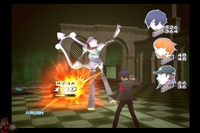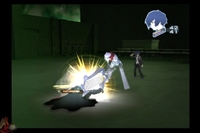|
|

|
PLATFORM
|
PS2
|
BATTLE SYSTEM
|

|
INTERACTION
|

|
ORIGINALITY
|

|
STORY
|

|
MUSIC & SOUND
|

|
VISUALS
|

|
CHALLENGE
|
Easy to Medium
|
COMPLETION TIME
|
80-100 hours
|
|
OVERALL

|
Click here for scoring definitions
|
|
|
What was going through the minds of the designers as they imagined Shin Megami Tensei: Persona 3 can only be speculated upon, but the results cannot be argued with. The combination of a traditional dungeon-crawler RPG with a dating simulator is probably the most bizarre genre cross-over in existence, and yet it works exceedingly well on almost every level. Average high school students by day, demon-hunting warriors by night, Persona 3 essentially offers two separate games that affect one another on multiple levels, leaving the player with an experience unlike any other. Plus, the characters regularly and repeatedly shoot themselves in the head - what other game can say that?
The unnamed main character begins the game as a transfer student arriving at his new dorm. He is soon swept into an ongoing battle that takes place during the Dark Hour, a hidden hour that occurs every night at midnight, but which normal human beings don't experience. The story progresses from there along two paths. One is his high school life, where he can make friends, develop romantic entanglements, study for exams, hang out, and just generally live a normal life. The second is that of his life during the Dark Hour, where he and his dormmates, collectively known as the Special Extracurricular Execution Squad (SEES), hunt down the demons that awake during this special time, called shadows, and explore the randomly-generated floors of the strange tower Tartarus that appears where their school would normally be.
The members of SEES, the main character included, have a special ability that allows them to stay aware during the Dark Hour. The game's namesake, "personas" are special beings that live within each of the members and grant them special powers that can defeat the shadows. While each of the AI-controlled members are limited to a single persona, the main character has the unique ability to gather and change between multiple personas as he wishes, which is essential to effectively defeat opponents and progress through the game. The main character is also unique in another way, purely from a story-telling standpoint. While many other RPGs feature a silent, unnamed protagonist, Persona 3 is unusual in that it allows the player an incredible amount of leeway over how this character thinks, feels, and acts. Hardly ten minutes go by without some sort of dialogue choice being offered, and the choices made affect how other characters treat you. In this manner, Persona 3 completely immerses the player in the game's world, as the main character isn't just some bland fighter - he is you, through and through.
Even as the game begins, this emphasis on choice is clear. One of the first things the player will do as he enters the game is sign his name to a contract, which simply states, "I chooseth this fate of mine own free will." The heaviest impact from these choices comes in the form of "Social Links," which are friendships that the player is free to build upon, and offer experience bonuses when fusing different personas. These social links are what tie the dating simulator aspects of the game to the more traditional RPG conventions. While your days will be spent developing these friendships, when the clock strikes twelve, it's time to head into battle.
 Abusing enemy weaknesses is the key to victory.
Abusing enemy weaknesses is the key to victory.
|
|
Persona 3 uses a battle system that is quite similar to previous entries of the Shin Megami Tensei series, particularly the Press Turn system of Nocturne and Digital Devil Saga. There are several notable differences, however, the most gratifying of which is the removal of random encounters. Enemies appear on the dungeon map, and striking them with your weapon (or them striking you) results in a battle, with advantage generally being given to whichever side struck first. Battles occur in a typical turn-based system, with the main character under the players control and allies controlled by AI. The AI is usually fairly intelligent, but occasionally it does perform rather stupid actions. Thankfully, tactical commands such as "Full Assault" or "Heal and Support" can be given to specific allies to ensure they follow the strategy you desire.
The biggest offensive advantage available, and also the primary reason the battle system is so much fun, is the addition of enemy weaknesses, which can be exploited to acquire additional turns. Unlike the Press Turn system of previous Shin Megami Tensei entries, however, you are not limited to a single additional turn per character. This is because additional turns are not granted for exploiting an enemy weakness, but for knocking them down, and as long as there are enemies to knock down, there are extra turns to be had. What's more, by knocking down all the enemies in a group, a special "all-out attack" becomes available that does significant damage to all enemies, usually enough to wipe the group out. In fact, most normal battles can be won without the enemy receiving a single turn.
Unfortunately, this works both ways, and enemies can also exploit the party's weaknesses, gaining extra turns themselves. If the player is struck from behind, the enemy receives the first round of attacks, and often times the results can be devastating, if not fatal. This is particularly the case of enemies that know the instant-death hama and mudo skills, which if successfully cast on the main character, can end your game at the drop of a hat. While some players may consider this random element a challenge, most will likely find it a severe irritation, and many hours of gametime can and will be lost to it. Eventually items can be found and traded for that will automatically negate these instant-death attacks should they succeed, as well as persona that are immune to them, but there are times when they are not available, and that is where the issues generally occur. Beyond the instant death skills, even something as simple as missing a critical attack can lead to a premature game over, furthering the frustration.
These issues are minor, however, when compared to the overwhelmingly addictive nature of the battle system. Because of the focus on abusing weaknesses, every battle requires a significant amount of strategy from the player, keeping it fun and fresh throughout the game's exceptionally long duration.
 Disclaimer: RPGamer in no way condones teenage suicide, no matter how cool it may be.
Disclaimer: RPGamer in no way condones teenage suicide, no matter how cool it may be.
|
|
The game progresses at a steady pace, allowing the player to switch between the dating simulator aspects and the role-playing game aspects whenever desired for the most part. While the stories presented by the different social links are entertaining, the meat of the plot occurs once a month, and while it begins fairly slowly, it picks up steam towards the middle, twisting and turning to one of two possible conclusions. The story also presents a number of surprises throughout, which are certain to leave the player speechless. All the characters are extremely well developed, with individual, often conflicting personalities that enhance their interaction as the story moves on. Amazingly, the localization is also completely faithful to its Japanese origins, keeping all the formalities intact, as well as presenting a very authentic Japanese high school experience.
Persona 3's graphical style helps to accentuate the experience of living in Japan, providing a realistic urban center with anime-styled characters. Several key locations provide the backdrop for most of the game, including a shuttle train, a shrine, and a mall. While the graphics aren't as technically impressive as others on the PlayStation 2 platform, they are still eye-catching, and the engine-driven cutscenes are regularly punctuated by impressive anime sequences. Unfortunately, since the game takes place in a fairly constricted area, the player will regularly be visiting the same places over and over again, which can get stale after a while. This is alleviated somewhat by the changing of the seasons, which will often cause subtle variations to the details in certain areas, but it is short-lived.
An impressive soundtrack spearheaded by series composer Shoji Meguro stands prominently at the center of the auditory experience that Persona 3 offers, and it definitely stands out as one of his better works. Featuring an interesting mix of techno, hip-hop, and J-pop styles, the tracks are almost all extremely memorable and very catchy. In addition, the voice acting is superb, with a lot of subtle inflections, which would generally be missed in other games, being performed perfectly. The plot regularly features exceptionally emotional scenes, and it is at these times that the voice acting really stands out.
The game comes bundled with a copy of the official soundtrack as well as an art book, an addition which is sure to see much use. The soundtrack contains eighteen tracks from the game, including the addictively jazzy battle theme and the wonderful ending piece. The artbook contains a number of full-color illustrations and character sketches, as well as thoughts from the art director, Shigenori Soejima, on several of the characters and key locations.
Persona 3 is filled with memorable characters, riveting gameplay, and a lengthy campaign that is likely to take most players eighty or more hours to complete. While the Shin Megami Tensei series has long been known for its exceptional difficulty, Persona 3 is thankfully much easier, allowing for a wider audience to experience it. The game also offers the player an easy difficulty, which provides easier battles and ten continues, in case something unfortunate happens. Even so, the normal difficulty shouldn't present too many problems for the experienced RPGamer, and it is an experience that no RPGamer should do without.
Review Archives
|









